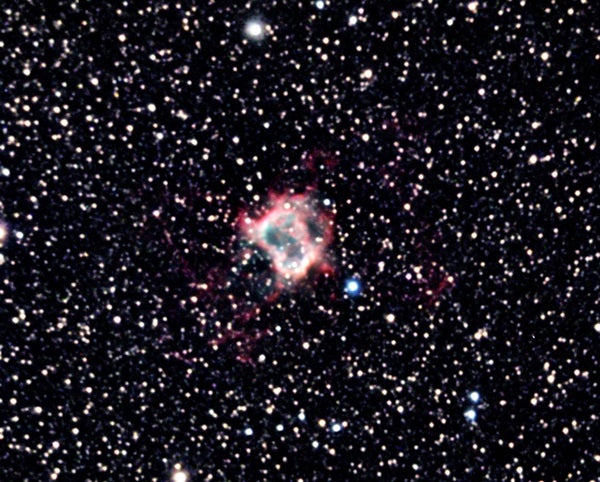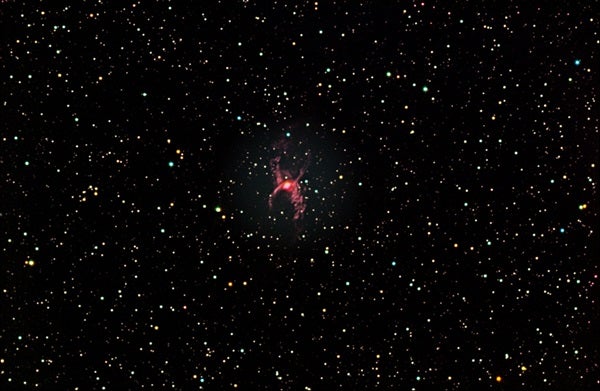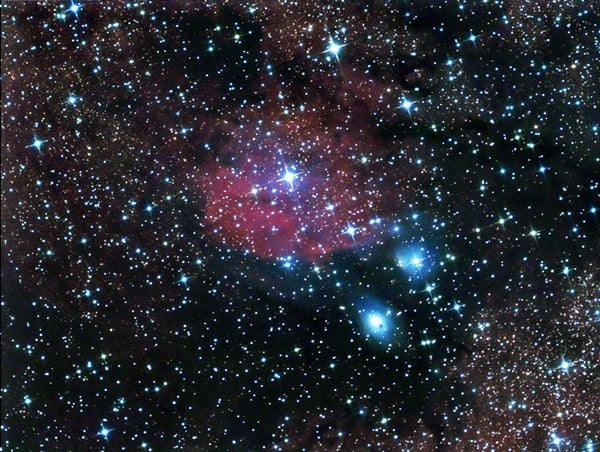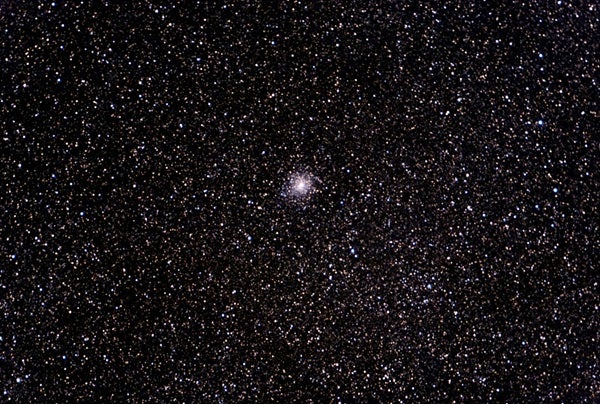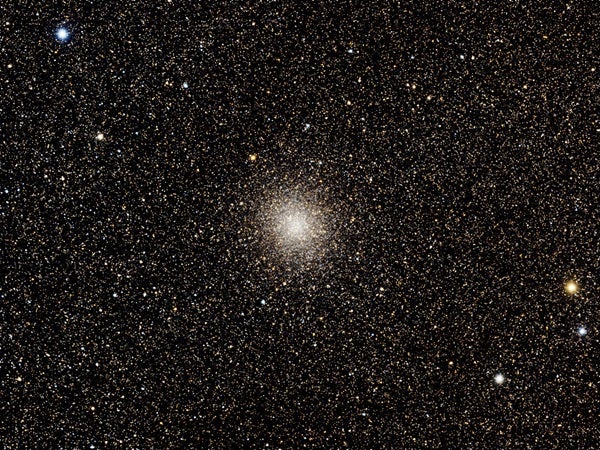Editor’s Note: In the August issue, the declination lines in “40 deep-sky targets in Sagittarius“ were labeled incorrectly. We apologize for the error, and please find a corrected version of the story for you to download below.
17h49m, –20°22′
This target lies 5.9° west of magnitude 3.8 Mu (μ) Sagittarii. NGC 6440 is small and reasonably faint. Its main claim to fame is that it sits less than 0.4° south-southwest of NGC 6445. Insert your highest-power eyepiece that gives at least a half-degree field of view. The globular itself shows a wide, concentrated core surrounded by a thin halo of unresolved stars.
NGC 6445
17h49m, –20°01′
Our next target lies 5.8° west of magnitude 3.8 Mu Sagittarii and less than 0.4° north-northeast of NGC 6440. NGC 6445 is the second “Box Nebula” amateur astronomers talk about. The other is NGC 6309 in Ophiuchus.
Astronomers classify NGC 6445 as a bipolar planetary nebula, and, as its name implies, it does have a distinct rectangular shape. Through a 12-inch telescope at 250x, you’ll see the two relatively bright lobes, one to the northwest and the other to the southeast, separated by a dark central region. Larger telescopes show this planetary as a thin rectangle with a large, dark central void.
M23 (NGC 6494)
17h57m, –19°01′
M23 is a small-telescope target and one of Charles Messier’s least-observed objects. That’s a shame because it’s gorgeous. To locate this fine sight, point your telescope, or even binoculars, 4.4° west-northwest of magnitude 3.8 Mu Sagittarii, toward the thickest part of the Milky Way.
This open cluster shines at magnitude 5.5 and measures 27′ across, a size equal to the Full Moon. It shows up clearly through a finder scope, and you might even catch its faint glow without optical aid from a dark site.
Through a 4-inch telescope at 100x, you’ll see a gorgeous cluster with 50 stars spreading out into several curving rows of stars. (I can make five distinct chains.) Although the surrounding star field is rich, you’ll have no trouble identifying where M23 ends. The brightest non-cluster star in the area is magnitude 6.5 SAO 160909, which lies 20′ northwest of M23’s center. If you have access to larger telescopes, you’ll see more stars up to a limit of about 100 cluster members.
M20 (NGC 6514)
18h02m, –23°02′
Our next treat is the magnificent Trifid Nebula, an object French comet hunter Charles Messier discovered June 5, 1764. This object owes its common name to three dark dust lanes that converge in front of the brighter emission nebulosity. Look for a nice triple-star system just west of center. These three stars, and two more, provide the ultraviolet radiation that causes M20 to glow. On the Trifid’s northern edge sits a reflection nebula, shown as blue in photos. This region reflects the light of the 9th-magnitude star that sits at its center. You’ll want to set a lot of time aside to observe this object.
You’ll find M20 3.3° southwest of magnitude 3.8 Mu Sagittarii.
NGC 6520
18h03m, –27°53′
This open cluster lies 2.6° north-northwest of magnitude 3.0 Al Nasl (Gamma2 [γ2] Sagittarii). Through a small telescope, you’ll see a well-defined cluster against a bright background of distant stars. Through an 8-inch telescope, 30 stars of magnitudes 10 and 11 sit in the central one-third of the cluster. Scan the region to the west and south at about 150x, and you’ll see far fewer stars. What you’re looking at is the dark nebula Barnard 86.
Astronomy magazine Contributing Editor Stephen James O’Meara calls this object the Castaway Cluster in honor of Robinson Crusoe because, to him, the view around NGC 6520 is so grand that the cluster looks like some lonely, uncharted isle in a tempestuous sea.
NGC 6522
18h04m, –30°02′
For our next treat, head 0.6° northwest of magnitude 3.0 Al Nasl (Gamma2 Sagittarii). A region of low obscuration known as Baade’s Window, named for German astronomer Walter Baade, enables us to see this cluster, which lies 90 percent of the way to our galaxy’s center.
A 12-inch telescope will resolve several dozen stars around a strongly concentrated core you won’t resolve. You’ll also spot a magnitude 11.4 foreground star less than 2′ from the cluster’s eastern edge.
Finally, look 16′ to the east of NGC 6522 for another globular cluster, magnitude 9.6 NGC 6528.
M8 (NGC 6523)
18h04m, –24°23′
Look 5.5° west of magnitude Lambda (λ) Sagittarii for the magnificent Lagoon Nebula. Around 1680, English astronomer John Flamsteed discovered what became the eighth object on Messier’s list.
You’ll spot this object with your naked eyes from a dark site. It measures three times as wide as the Full Moon, and you’ll be able to follow most of the nebulosity through your telescope. A dark lane (the lagoon) cuts the object in half. On the eastern side of the rift, you’ll see three dozen stars of open cluster NGC 6530 embedded in the gas.
The brightest star west of the lane is the magnitude 5.9 star 9 Sagittarii, which is responsible for the nebula’s glow. A bit more to the west is M8’s core, a region of intense brightness. Look for the Hourglass Nebula, a star-forming region with lots of young stars.
M21 (NGC 6531)
18h04m, –22°29′
You’ll find this relatively unobserved Messier object 2.6° southwest of magnitude 3.8 Mu Sagittarii. I’m pretty certain you’ll sweep up the Trifid Nebula (M20) first, so when you do, move 42′ northeast for M21.
Through a 6-inch telescope, you’ll see two dozen stars brighter than 12th magnitude. The magnitude 7.2 star SAO 186215 shines at the cluster’s center.
18h05m, –19°51′
Our next target sits 2.3° west-northwest of magnitude 3.8 Mu Sagittarii. Pull out a 12-inch or larger telescope to view this object. At any magnification below 250x, the Red Spider Nebula appears starlike. Above that limit, you’ll see a round bluish disk. An Oxygen-III filter helps bring out this nebula, but you won’t see the object’s blue color through it.
NGC 6544
18h07m, –25°00′
Our next object lies 1° southeast of the magnificent Lagoon Nebula (M8). Any size telescope will show you this cluster, but few amateur scopes, no matter their size, will resolve the stars within it. A magnitude 10.7 star sits 28″ to the east-northeast of the small core.
Astronomy magazine Contributing Editor Stephen James O’Meara calls this the Starfish Cluster because its brightest stars form a starfish-shaped pattern at high magnification.
NGC 6553
18h09m, –25°54′
This open cluster lies 4.2° west of magnitude 2.8 Kaus Borealis (Lambda Sagittarii). Through an 8-inch telescope at 150x from a dark site, you’ll see this cluster’s triangular appearance. I think of it as an arrowhead pointing toward the southeast. The arrowhead’s northeast tip is the brightest. Look for two stars of about magnitude 11.6, each less than 1′ from the cluster’s center. One lies to the northeast and the other toward the west-southwest.
NGC 6558
18h10m, –31°46′
Our next target sits 1.6° southeast of magnitude 3.0 Al Nasl (Gamma Sagittarii). Through a 12-inch telescope at 150x, I noticed four 12th-magnitude stars in the shape of the constellation Corvus that frame this cluster. The cluster itself appears faint, small, and unresolvable. Several curving lines of stars, especially toward the south, add to the overall appeal of the view.
IC 1274
18h10m, –23°39′
You’ll find this small combination emission and reflection nebula 0.4° west of the magnitude 5.0 star 11 Sagittarii. The cloud stands out through a medium-size telescope mainly because it sits next to an equally large region of darkness called Barnard 91. Several relatively bright stars are easy to spot within IC 1274, and their radiation helps light up the nebulosity.
NGC 6559
18h10m, –24°07′
Here’s an often-overlooked object in Sagittarius, but it shouldn’t be. You’ll find it 1.4° east of the Lagoon Nebula (M8). This spectacular star-forming region would get a lot more ink if it lay elsewhere. But most amateurs focus on nearby M8 and the Trifid Nebula (M20).
For imagers, few regions of nebulosity show the variety of color and detail that NGC 6559 does. Wispy dark clouds hang delicately in the foreground of diffuse, glowing hydrogen gas. Follow the clouds toward a bright red arc of gas that shields luminous stars beneath it.
Although these stars try to push away the gas and dust near them, thick portions remain and continue to scatter light. This colors the area with hints of blue and purple. Use a nebula filter to see the emission nebulosity, but remove the filter if you’re looking for blue reflection nebulosity.
NGC 6563
18h12m, –33°52′
To find our next object, look 2.5° west of magnitude 1.8 Kaus Australis (Epsilon [ε] Sagittarii). Through an 8-inch telescope at 200x, this nebula shows a pale disk. A 14-inch scope reveals that the outer edge is ever so slightly brighter. A nebula filter (such as an Oxygen-III) really helps. Rather than round, this planetary shows a slight oval shape inclined northeast to southwest.
NGC 6569
18h14m, –31°50′
Our next target sits 2.2° southeast of magnitude 3.0 Al Nasl (Gamma Sagittarii) in a rich and appealing star field. Through a 10-inch telescope at 200x, this globular appears stretched ever so slightly with a general northeast to southwest orientation. The tiny core is a bit brighter than the small halo, and a faint mottling suggests the presence of individual stars, but I didn’t resolve any.
A rough “W” shape of stars lies just to NGC 6569’s south. Continue almost 9′ south of the cluster, and you’ll arrive at magnitude 6.8 SAO 209873.
18h17m, –19°47′
This is one of two evident reflection nebulae in this region. The other is our next object, NGC 6590. Such objects reflect and scatter light from nearby bright stars. In the case of these two nebulae, the stars belong to open cluster NGC 6595, which lies at a distance of approximately 5,900 light years. You’ll find this object, and NGC 6590, 1.5° north-northeast of magnitude 3.8 Mu Sagittarii.
NGC 6590
18h18m, –19°52′
This reflection nebula pairs with our previous object, NGC 6589. It lies 6′ south-southeast of the other cloud.
M24 (NGC 6603)
18h18m, –18°24′
With everything going on in this incredibly rich region, it’s tough to explain why Charles Messier placed M24, an obvious star cloud, on his list. It spans nearly 2° and measures 0.6° wide. I suggest a first look at M24 though 15x binoculars. You’ll find it 3° north of magnitude 3.8 Mu Sagittarii.
Toward the northwest end of the star cloud is the object actually designated NGC 6603, a magnificent open cluster of several dozen stars. Only 4 south of the cluster, you’ll see the magnitude 7.4 foreground star SAO 161294.
Father Pietro Angelo Secchi (1818¬–1878) called the Sagittarius Star Cloud “Delle Caustiche,” as he said, “from the peculiar arrangement of its stars in rays, arches, caustic curves, and intertwined spirals.”
Barnard 92
18h18m, –18°04′
Less than 1° west-northwest of NGC 6603 lies Barnard 92, a prominent, small, dark nebula shaped like a fingerprint. The only break in its darkness is the magnitude 11.4 star GSC 6268:517. It is one of the first dark nebulae known, discovered in 1913 by Edward Emerson Barnard.
M18 (NGC 6613)
18h20m, –17°06′
You’ll find another of Charles Messier’s lesser-known objects 4.2° north-northeast of magnitude 3.8 Mu Sagittarii. A 4-inch telescope reveals about a dozen stars. Larger telescopes don’t show many more, and higher magnifications spread the cluster out so much that, in effect, it gets lost among the background stars.
M17 (NGC 6618)
18h21m, –16°11′
The Omega Nebula (also known as the Swan Nebula, the Checkmark Nebula, and the Horseshoe Nebula) lies 2.6° southwest of magnitude 4.7 Gamma Scuti. Swiss astronomer Jean-Phillippe Loys de Chéseaux (1718–1751) discovered M17 (and M16) about 1746. Through a 6-inch telescope, the Omega Nebula appears as a bright bar 7′ long with a short extension from the west end to the south. Increase the magnification past 150x, and the extension reveals itself as a hook-shaped feature with dark material obscuring light from its central region. Through a 12-inch or larger scope, you’ll see much more nebulosity — and the brightest regions will show fine striations.
NGC 6624
18h24m, –30°22′
This globular cluster lies 0.8° southeast of magnitude 2.7 Kaus Media (Delta [δ] Sagittarii). Through a 4-inch telescope, you’ll spot this cluster easily as round and evenly bright. A 10-inch scope at 250x reveals the outer edge as irregular and the tiny center brighter than the halo.
18h25m, –24°52′
This bright globular cluster lies 1° northwest of magnitude 2.8 Lambda Sagittarii. Through an 8-inch telescope at 150x, you’ll resolve several dozen stars in the wide halo. Through a 14-inch scope, your star count will climb past 150. Viewing the core at 250x or above gives a three-dimensional effect. A relatively bright chain of stars extends to the north. Another fainter one heads to the north-northwest.
M69 (NGC 6637)
18h31m, –32°21′
To find our next target, another globular cluster that Charles Messier put in the middle of his list, look 2.5° northeast of magnitude 1.8 Kaus Australis (Epsilon Sagittarii). M69 sits near the southwest corner of the Teapot asterism.
M69 lies 30,000 light-years from us and only 6,000 light-years from the center of the Milky Way. Astronomers classify it as one of the most metal-rich globulars, which means its stars have relatively high concentrations of elements heavier than helium. That amount is much less than that of our Sun, however, dating M69’s stars to be much older than the one we orbit.
Through an 8-inch telescope, you may have a bit of trouble resolving this globular’s stars. Its core appears broad but concentrated, and a thin halo surrounds it. The cluster lies within a rich star field, so crank up the magnification — it can take it.
Through a 14-inch scope, you’ll be able to resolve about a dozen of M69’s stars, but even with that size instrument, it won’t be easy. Look for three clumps of faint stars that form a triangle close to and surrounding the cluster’s center, one to the northwest, one southwest, and the third one to the east. Oh, and the magnitude 8.0 star that sits a bit more than 4′ northwest of M69’s center is SAO 210259.
NGC 6638
18h31m, –25°30′
Our next target — another globular cluster — lies 0.7° east of magnitude 2.8 Kaus Borealis (Lambda Sagittarii). Through an 8-inch telescope at 150x, this conglomeration appears round with a small, condensed core and a thin halo. Magnitude 9.9 SAO 186904 lies a bit more than 3′ to the south-southwest of the cluster’s center.
NGC 6642
18h32m, –23°29′
This globular cluster sits 2.1° north-northeast of magnitude 2.8 Kaus Borealis (Lambda Sagittarii). Through a 10-inch telescope at 250x, you might notice a slight widening of the central area in a northwest to southeast orientation. That core region remains unresolvable through much larger scopes, although it somewhat resembles a dumbbell. A wide double star lies 2′ north-northwest. The components shine at magnitudes 10.7 and 12.4 and lie 30″ apart. Another, with orange magnitude 7.7 SAO 186912 as the primary and a magnitude 10.9 secondary, lies 12′ northwest. That pair’s separation also measures 30″.
M25 (IC 4725)
18h32m, –19°07′
This open cluster lies 4.4° east-northeast of magnitude 3.8 Mu Sagittarii. It’s visible to the naked eye from a dark site, but not easily because of the richness of the Milky Way background.
A 6-inch telescope at 125x reveals 50 member stars. Two chains of stars stretching east to west lie near the center. A starless gap divides them. Many of M25’s stars exceed 11th magnitude, making this a nice sight through small telescopes. Yellow magnitude 6.8 SAO 161557 sits at the northwest edge.
NGC 6645
18h33m, –16°53′
Move your telescope 2.4° north of our previous treat, M25, to discover NGC 6645, another fine open cluster. Through an 8-inch telescope, you’ll count 50 stars. The feature you want to see lies near the center of the cluster. It’s a circlet of 15 stars whose center is empty. A line of a half-dozen stars protrudes from the eastern side and heads toward the east-northeast for nearly 10′.
NGC 6652
18h36m, –32°59′
This relatively bright globular cluster sits 2.8° east-northeast of magnitude 1.8 Kaus Australis (Epsilon Sagittarii). Through a 6-inch telescope at 125x, this object has a compact core with an irregular halo around it. A 14-inch scope at 300x won’t resolve any of its stars, but it will expand the core enough to make it appear wedge-shaped, pointed toward the east-southeast. Magnitude 6.9 SAO 210344 lies 7′ northwest of the cluster’s center.
18h36m, –23°54′
One of the most spectacular objects in Sagittarius is globular cluster M22. This easy naked-eye object ranks as the sky’s third-brightest globular, exceeded only by Omega Centauri (NGC 5139) and 47 Tucanae (NGC 104).
When you observe M22, altitude — how high it appears in the sky — is everything. Many amateur astronomers in Northern Europe, Canada, and the northern United States are unaware of this cluster’s magnificence because, for them, it hugs the southern horizon. See it high in the sky, however, and you’ll understand the hype.
Through even a 4-inch telescope, you’ll see several dozen stars. Pay attention to the bright starry background, which adds character to the scene. Try to discern exactly where the outer boundary of M22 ends and the background begins.
Move up to a 10-inch scope, and you’ll be overwhelmed by hundreds of member stars. You can try counting them by dividing M22 into eight wedge-shaped pieces. Count the stars in just one wedge, then multiply by 8.
M22 lies 2.4° northeast of magnitude 2.8 Kaus Borealis (Lambda Sagittarii).
M70 (NGC 6681)
18h43m, –32°17′
This southerly Messier object lies midway between magnitude 2.6 Ascella (Zeta [ζ] Sagittarii) and magnitude 1.8 Kaus Australis (Epsilon Sagittarii). M70 is similar in brightness to M69 but has a more sharply concentrated center. Through an 8-inch telescope at 200x, you’ll see a bright core and a thin halo in which you can resolve half a dozen stars. A short line of relatively bright stars shoots northward from the cluster’s eastern side.
M70 has an association with Comet Hale-Bopp (C/1995 O1). Neither discoverers Alan Hale nor Thomas Bopp was actively comet hunting when they made their discoveries July 23, 1995. They merely pointed telescopes at M70 and spotted a foreign object in the field of view.
M54 (NGC 6715)
18h55m, –30°29′
Our next treat lies 1.7° west-southwest of magnitude 2.6 Ascella (Zeta Sagittarii). Although its total magnitude is bright, M54’s stars only resolve through the largest amateur telescopes. That’s because it lies 87,000 light-years away, making it the most distant globular cluster in Charles Messier’s catalog. Its brightest stars shine at only magnitude 15.5.
Through a 12-inch telescope, M54’s center appears broad and bright. A razor-thin halo surrounds it, but you’ll need to crank up the magnification past 350x to see it.
NGC 6716
18h55m, –19°54′
This object sits 1° northwest of magnitude 5.0 Xi1 (ξ1) Sagittarii, and it’s one I put into the class I call the “great equalizer” clusters. That means NGC 6716 looks as good through a 4-inch telescope as it does through a 12-inch one. Sure, you may see more ultra-faint stars when you use a larger aperture, but the essence of the cluster will be the same.
So, through a 4-inch or larger scope, you’ll see two distinct groupings of stars with a gap between them. A curved arc of half a dozen 9th- and 10th-magnitude stars sits to the north, and a second group whose shape reminds me of the Coathanger cluster (Collinder 399) lies to the southwest. Adding a splash of color is the orange magnitude 7.0 star SAO 161947, which lies 12′ to the west-northwest of NGC 6716’s center.
NGC 6717
18h55m, –22°42′
Our next object is a globular cluster you’ll find 1.7° south-southwest of magnitude 3.5 Xi2 Sagittarii. When you arrive at that location, however, you’ll encounter a problem: Magnitude 5.0 Nu2 (ν2) Sagittarii lies less than 2′ north of our target. Through small telescopes, the globular appears as a hazy patch near the star. Be sure to crank the power up to at least 200x to put some separation between the two objects.
At that magnification, or through a larger scope like the 12-inch with which I last observed NGC 6717, you’ll first spot several foreground stars, the brightest of which shines at magnitude 11.7. Those stars seem superimposed on a nebulous background glow, and that’s what you’re trying to see. I think of Bruce Lee’s instruction to his student in the 1973 movie Enter the Dragon: “It’s like a finger pointing the way to the Moon. Don’t concentrate on the finger, or you’ll miss all that heavenly glory.”
NGC 6717 carries another astronomical designation — Palomar 9. In fact, it’s the brightest (by more than a magnitude) of any from that relatively obscure list of 15 deep-sky targets.
NGC 6723
19h00m, –36°38′
The gorgeous Chandelier Cluster (NGC 6723) sits 0.5° north-northeast of magnitude 4.8 Epsilon Coronae Australis, within a region rich in reflection nebulosity.
Through an 8-inch telescope at 200x, you’ll see a large, concentrated core that exhibits mottling (alternating bright and dark regions). Two dark gaps lie at the cluster’s southwestern edge.
Through a 14-inch scope, crank the magnification up to 300x, and you’ll see NGC 6723’s irregular shape plus many more individual stars. Do you see the draping arcs of stars for which this globular got its popular name the Chandelier Cluster? A 16-inch scope will reveal more than 100 faint points of light. The brightest star in view glows at magnitude 10.4 and lies 3′ from the cluster’s center.
M55 (NGC 6809)
19h40m, –30°58′
Our next treat is another globular cluster from Charles Messier’s catalog. M55 is a superb object you may just spot with your naked eye from an ultra-dark site. Observers describe this cluster as “highly resolved.” That means its core doesn’t appear packed with stars, which often gives a “burned out” effect.
A 12-inch telescope at 300x will break it into hundreds of 11th- and 12th-magnitude stars. Through an eyepiece with a small field of view, M55 may appear more like a rich, open cluster.
You’ll find M55 8° east of magnitude 2.6 Ascella (Zeta Sagittarii).
NGC 6818
19h44m, –14°09′
The treat amateur astronomers call the Little Gem (NGC 6818) sits in a no man’s land bereft of bright stars near the Archer’s northern border with Aquila. Look for this small planetary nebula 9° due west of 3rd-magnitude Beta (β) Capricorni. Although stellar luminaries in this part of the sky are scarce, this is a great area for deep-sky treats. The Little Gem lies only 0.7° north-northwest of Barnard’s Galaxy (NGC 6822). Talk about two objects that are on the opposite ends of the surface brightness spectrum!
As luck would have it, the Little Gem is the bright one. It shines at magnitude 9.3 and measures roughly 0.8′ across from north to south and a bit less from east to west. The combination of brightness and size means NGC 6818’s surface brightness is high, and you can really crank up the magnification. The greenish-blue color most observers see appears best at around 100x. Above that power, look for this object’s ever-so-slightly darker inner half.
Observers began to refer to this planetary as the Green Mars Nebula when they noticed its size through a small telescope (22″, less than half its listed diameter) equaled that of Mars when the Red Planet approaches closest to the Sun.
NGC 6822
19h45m, –14°48′
If you use an 8-inch or larger telescope, insert the eyepiece that gives you the widest field of view, and look for Barnard’s Galaxy, also known as NGC 6822. This object lies in Sagittarius 1.5° north-northeast of 5th-magnitude 55 Sagittarii. In 1881, American astronomer Edward Emerson Barnard discovered this object through a 6-inch refractor.
Barnard’s Galaxy shines at magnitude 9.3 — pretty bright for a galaxy. Unfortunately, its light spreads out over an area 16′ by 14′, so its overall surface brightness is low.
Look for a dim haze roughly twice as long as it is wide. Note the slightly brighter streak that spans NGC 6822’s long axis.
Larger scopes show several star-forming regions along the galaxy’s northern end. To see just these, use a nebula filter. Without a filter, and through a 12-inch or larger scope, look for individual supergiant stars. They’re faint — the brightest glow at only 14th magnitude — but they reveal themselves by lending a granular appearance to the galaxy.
M75 (NGC 6864)
20h06m, –21°55′
Our next object is globular cluster M75, which lies 60,000 light-years away. Because of its vast distance, you’ll have trouble resolving even its brightest stars through a 12-inch telescope. The core appears bright and stellar at low magnification. Although M75 is in Sagittarius, it’s outside the Milky Way’s band, so the field is bereft of foreground stars. You’ll find it 5° north-northeast of magnitude 4.7 Omega (ω) Sagittarii, next to that constellation’s border with Capricornus.

